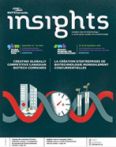The Evolving Biotechnology Regulatory Landscape
From blood products and vaccines to gene markers, gene therapy and RNA interference, the technology of biological based therapeutics is changing at an exponential rate. Challenges for the efficacy and safety of these stem from characterization of a therapy, manufacture, quality control, distribution and use. Regulatory authorities in the USA and around the globe are working to keep up with technology which results in a rapidly changing regulatory landscape. This document is intended to summarize some of the key changes that have occurred over the last several decades.
Contents:
Primary Regulatory Institutions
The Transition from Small Drugs to Biologics
Humanization and Engineering of Biologics
Elucidation of the Human Genome
Gene Therapy and RNA Interference
Monoclonal Antibodies Lead New Biotechnology Development
Medical Devices and Diagnostics
Primary Regulatory Institutions
In the USA, federal regulation of drugs and devices including diagnostics begins with the Food, Drug and Cosmetic Act approved by Congress in 1938 and is supported by the US Constitution’s requirement for the Federal Government to regulate interstate commerce. The intent is to protect the American public from products that have limited or no efficacy or significant safety concerns when used as recommended by a manufacture either for the treatment of a medical condition or to aid physicians in making decisions about medical treatment. The FDA is currently structured in several divisions: Center Drug Evaluation and Research (CDER) for drugs, Center for Biologics Evaluation and Research (CBER) biologics, and Center for Devices and Radiological Health (CDRH) for devices including diagnostics. In Europe and internationally, centralized regulation of drugs and devices originated with the formation of the European Agency for the Evaluation of Medicines in 1995 (now the European Medicines Agency or EMA) responsible for approval of market authorization applications with its Committee for Medicinal Products for Human Use (CHMP) responsible for guidance and the International Conference on Harmonisation of Technical Requirements for Registration of Pharmaceuticals for Human Use (ICH) in 1990. The ICH has produced a range of standards for development of pharmaceuticals that have been adopted by the FDA, CHMP, Health Canada and the Ministry of Health, Labor and Welfare (MHLW) in Japan.
The Transition from Small Drugs to Biologics
Many of the drugs under regulation initially were small molecular weight entities and simple formulations that were manufactured under highly controlled and definable chemical processes. The main exceptions were vaccines and blood products which were made through biological processes that are inherently more variable and more difficult to control. Since the first introduction of a recombinant protein, Humulin-R in 1982, biological drugs and devices including diagnostics have been introduced at an exponentially increasing rate. This required a dramatic shift in how these products are regulated. Biologics were first managed under the guidance of the National Institute of Health (NIH) but were shifted to FDA’s division CBER in 1972. This shift was due to the challenges inherent in manufacturing and quality control of biologically derived materials which are much more difficult to define quantitatively and have degrees of variation in yield and purity that are nevertheless consistent with the use and safety of the products. Beginning in 1982 with recombinant insulin and subsequently with a range of recombinant products, antibodies and monoclonal antibodies, a more definable class of biologically derived products evolved. These products require an Investigational New Drug application (IND) in the USA or Clinical Trial Authorization (CTA) in Canada and Europe during investigation and development and a Biologics License Application approval (BLA) prior to marketing which approves the product for specific clinical uses while acknowledging the inherently greater complexity in manufacturing and quality control. In 1987, with the formation of CDER and CBER, the window was opened for a shift of some biologicals to review divisions with significant drug development capacity and clinical experience.
Humanization and Engineering of Biologics
Human proteins have a distinct advantage as therapeutics since they minimize immunogenicity especially with chronic administration. Engineering of the human sequence can lead to desirable pharmacokinetic or pharmacodynamic properties that increase the therapeutic ratio. Recombinant protein production involves inserting a human native sequence or engineered sequence gene into the appropriate cell line, often E. coli for polypeptide proteins and mammalian cells for glycosylated or post-translationally modified proteins. These cell lines are optimized and culture conditions adapted for high yield production. Purification and sometimes proteolytic modification are utilized next to achieve a drug product of the appropriate quality with limits on proteins derived from the cell host that may increase immunogenicity. This kind of manufacturing process leads to special quality control requirements for biotechnology products as described in this guidance.
Biosimilars
The combination of very high cost of branded biotechnology products along with improvements in manufacturing and quality control have led to the introduction of regulation for biosimilars or “generics” for biologics loosing patent protection. The Patient Protection and Affordable Care Act of 2010 introduced an abbreviated licensure pathway for biosimilar and interchangeable products that would help advance the introduction of price competitive alternatives. The EMA has also developed their pathway for biosimilars.
Elucidation of the Human Genome
Since the completion of the Human Genome Project in 2003, there has been a scramble to target specific human proteins that are central to the pathogenesis of a range of diseases. Many of these have been for rare diseases which have not received attention by therapeutic developers. The Orphan Drug Act of 1983 helped to advance the cause of treatments for diseases where the size of the population is very small but the medical need great. The idea was to reduce the regulatory burden allowing more orphan drugs to be developed and developed faster. Biotechnology products have often fit well into this category as they become designed around very specific targets and especially specific genetic mutations.
Companion Diagnostics
A powerful approach to optimizing therapy for specific individuals is the coupling of genomic markers with therapeutic treatment. An early and successful example is BRCA1 and BRCA2 for risk of breast and ovarian cancer. Reported in 1990, the presence of specific mutations in these two genes is a strong indication of the need for one of several types of prophylactic treatments depending on risk profile. When coupled to targeting biotechnology therapy, this is referred to as companion diagnostics. Herceptin is a monoclonal antibody which interferes with HER2 and indicated for HER2-positive breast cancer. Another example is Gleevec, a tyrosine kinase inhibitor indicated for Philadelphia chromosome –positive chronic myeloid leukemia or KIT-positive gastrointestinal stromal tumors. These are well known examples and have revolutionized therapeutic treatment. A number of examples are now well established.
Gene Therapy and RNA Interference
Other biotechnology developments related to genomics include gene therapy and RNAi (RNA interference). Human somatic gene therapy refers to products that introduce genetic material into a person’s DNA to replace faulty or missing genetic material. The FDA has a web site to coordinate and monitor gene therapy work. The death of a gene therapy volunteer in 1999 led to a reevaluation of this approach and to new requirements for tracking of subjects treated with gene therapy. RNAi refers to the use of oligonucleotides to interfere with gene expression. The discovery of micro RNA and small non-coding RNA as a key epigenetic gene regulatory mechanism that is important to development, cell differentiation and tumorigenesis has led to significant therapeutic opportunity. Although RNAi had been very successful in the nonclinical setting evaluating the importance of genes to pathogenesis, human study results were questioned as potentially resulting from activation of an immune response rather than the result of inhibiting gene expression in 2008. Key challenges remain including targeted delivery of gene therapy or RNAi and off target side effects and potential mutagenicity in spite of the theoretical promise for these approaches for anti-viral and cancer treatment although progress has been made to overcome these hurdles. Consequently no gene therapy or RNAi therapies have as yet been approved for use in the USA. The combination of oligonucleotide drug substance and the need for unique formulations for drug delivery lead to the need for highly specialized quality control and manufacturing process considerations.
Monoclonal Antibodies Lead New Biotechnology Development
Antibodies are biologics that have been very useful in nonclinical studies and have also demonstrated utility for therapeutics. The development of the monoclonal antibodies (MoAb) using the hybridoma technology reported in 1975 allowed for the generation of very specific targeted agents. Humanization of MoAbs was subsequently developed and allowed for therapeutics with significantly lower levels of immunogenicity. Phage display is another and more efficient approach to the development of human MoAbs. CDER now takes the lead in evaluating BLA submissions for monoclonal antibodies while an IND is still required for investigation use. There are now over thirty approved therapeutic monoclonal antibodies. Challenges in manufacture, quality control and evaluation of monoclonal antibodies include low yielding or genetically unstable cell lines, limitations of the expression system to produce full sized and high affinity antibodies, and immunogenicity of the agent even when humanized. Recent successes for monoclonal therapy are in the area of oncology where a variety of targeting strategies are being utilized including radioimmunotherapy, antibody-directed prodrug therapy, immunoliposome therapy and checkpoint therapy. Chimeric antibodies allow the combination of an antibody targeting a therapeutic target with an antibody targeting distribution or specific tissues. Especially promising are the immune-oncology targeted antibodies which help to restore the immune system response to tumor cells. The promise of monoclonal antibodies has been balanced by the often very high cost and the fact that treatment is often not curative requiring long term chronic use. To counter this, regulatory agencies are now considering biosimilar monoclonal antibodies.
Medical Devices and Diagnostics
In 1974, the Bureau of Medical Devices and Diagnostic Products was established and amended in 1976. The Investigational Device Exempt rule was introduced in 1980 to regulate medical devices that were intended for investigational use only (IDE). The Pre Market Approval is the path to approval of medical devices and diagnostics for interstate marketing in the USA where the device has no approved predicate whereas, the 510k notification allows for a more limited submission based equivalency to a predicate approved medical device. Determination as to whether a PMA or 510k is required is based on classification of the medical risk related to a false result. In 1988 the Clinical Laboratory Improvement Amendments (CLIA) were enacted to establish standards for laboratories especially those servicing Medicare & Medicaid patients. The Medical Device User Fee and Modernization Act introduced in 2002 were meant to speed up the investigation and approval of medical devices while having the sponsor cover some of the cost. The Medical Testing Availability Act of 2013 added to IDE, PMA and 510k designations the Investigational Use Only (IUO) and Research Use Only Designation (RUO) designations. Lab Developed Tests are tests that are designed, manufactured and utilized within a single laboratory. The FDA is now evaluating the higher risk versions of these tests. Careful consideration need be made determine the appropriate path for any new device or diagnostic given this complexity. As previously mentioned, companion diagnostics combine the complexity of both drug and device regulation.
Genetic markers and molecular profiling for disease and potential response to therapeutics offers personalized medicine and has exploded and is an area where regulation is beginning to be developed. Herceptin and the HER2 gene in treatment of breast cancer is an early and important example of the promise of this area. The Genomics and Targeted Therapy Group of CDER and the FDA Genomics Working Group and the Personalized Medicine Staff of CDRH’s OIR division are all working on aspects of this promising area.



